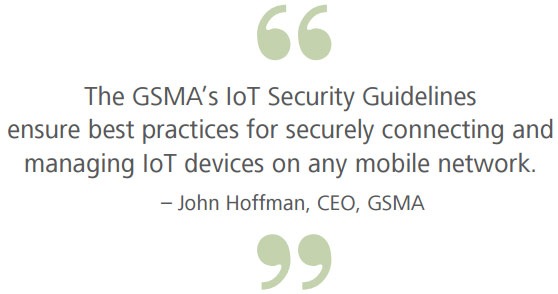Better Connected Living with GSMA
Connected Living is a key IoT initiative developed by GSMA. CEO John Hoffman tells us how it can help telcos make connected devices and services become a reality.


By Linda Xu & Gary Maidment
To fully unlock the value of the IoT, GSMA is working closely with operators to establish a robust IoT ecosystem. Its Connected Living program is a key initiative for helping operators to make connected devices and services a reality. GSMA CEO John Hoffman told us how the Connected Living programme is helping to mobilize IoT.
More than connectivity
GSMA’s Connected Living programme aims to promote a world in which consumers and businesses can access rich new services on an intelligent and secure mobile network. “We aim to achieve this through industry collaboration, optimizing networks, and encouraging the development of appropriate regulations,” states Hoffman. “We’re also working to develop key enablers that will support the growth of M2M in the immediate future and IoT in the longer term.” The program mainly covers five areas:

Mobile and trusted IoT: According to Hoffman, “We’re collaborating with mobile operators and ecosystem partners to develop Low Power Wide Area (LPWA) solutions that will enable IoT to scale.”
IoT security: The GSMA’s IoT Security Guidelines ensure best practices for securely connecting and managing IoT devices on any mobile network.
IoT connection efficiency: The GSMA works with its IoT ecosystem partners to establish guidelines for how machines should communicate on a mobile network in the most intelligent and efficient way.
IoT big data: Hoffman reveals that the GSMA are establishing the “IoT Big Data Ecosystem (BDE) by delivering harmonized data sets and APIs.”
Remote SIM provisioning: The GSMA has encouraged the industry to implement a single, robust and interoperable global remote SIM specification for M2M devices with an evolution path to connect all devices. “We’re also enabling the natural evolution of the SIM from physical to digital, simplifying connections on a wider range of consumer devices that are connected by secure mobile networks,” says Hoffman.
He believes that, “To bring IoT to the masses, collaboration is the way to solve the various issues affecting IoT,” of which there are quite a few.
Security
The predicted massive growth in IoT devices and applications will create big challenges for the IoT ecosystem, a major one being the risks caused by the mass deployment of inefficient, unsecured or defective IoT devices. These have the potential to create serious problems, including local issues in mobile networks like cell congestion, and capacity and performance problems in core networks such as signaling storms that can disrupt wide areas. Declining IoT service performance that causes delayed communications and even complete service outages could be disastrous in scenarios like healthcare, where constant monitoring is needed.
IoT is dependent on the efficient and intelligent use of secure mobile networks. “The GSMA has delivered a set of security guidelines to promote best practice for the secure design, development and deployment of IoT services,” states Hoffman. “A secure IoT market will create trusted, reliable services that can scale as the market grows.”
Big data analytics
IoT is generating a huge amount of data that’s currently retained in vertical silos. However, Hoffman feels that, “A true IoT is dependent on the availability and confluence of rich data sets from multiple systems, organizations, and verticals.” This, he feels, will usher in the next generation of IoT solutions.
GSMA is working with the mobile industry to establish an IoT BDE to make harmonized data sets from multiple sources available to developers and third parties through common APIs. This will enable the industry to remove the commercial and technical barriers to capitalizing on the wealth of opportunities that IoT offers.
A common, collaborative and interoperable approach to big data will usher in a new era of IoT solutions that help the market scale.

Three prioritized segments
“We’ve identified three major focus areas to develop IoT: smart cities, connected vehicles and health,” says Hoffman, when talking about GSMA’s priorities. In the area of smart cities, GSMA is working with mobile operators, governments, public venue managers, and city councils to highlight joint deployment approaches and deliver technology enablers for smart city solutions that can deliver real, long-term benefits to businesses and citizens. The connected vehicle market will be worth US$358 billion by 2020. GSMA has been working with mobile network operators and automotive original equipment manufacturers to accelerate the growth in this market, such as advancing car connectivity through billing and charging as well as through the GSMA Embedded SIM Specification which has become a de facto standard.
According to PwC, the use of IoT technology in healthcare could reduce costs by US$99 billion in the EU and add US$93 billion to the region’s GDP. GSMA’s health project under the Connected Living Program focuses on three main enabling factors: evaluating existing and emerging interoperability standards, ensuring clarity, and formulating regulations for digital health while developing cross-sector partnerships.

Economies of scale
Hoffman is convinced that “fragmentation within IoT industry leads to a lack of economies of scale, resulting in closed ecosystems that don’t work.” Last year, the GSMA founded the GSMA NB-IoT Forum with its partners, including Huawei. According to Hoffman, “The forum will provide all industry and wider ecosystem stakeholders with market representation to accelerate the widespread adoption of 3GPP-based NB-IoT technologies.”
The GSMA NB-IoT Forum aims to facilitate demos and proof-of-concept trials that strengthen the NB-IoT solution to meet LPWA requirements; lead partners to build a strong end-to-end industry chain for NB-IoT’s future growth; drive NB-IoT applications in vertical markets to create new business opportunities; and promote collaboration between all NB-IoT industry partners to ensure solution interoperability. “This represents our efforts to address interoperability for economies of scale, the key to long-term success,” says Hoffman.
The first NB-IoT network trials are already in place, with pre-commercial launches planned for the latter half of 2016, and commercial launches scheduled to take place globally in early 2017.
As one of the leading lights in the industry, GSMA is taking a holistic approach to the field of IoT, from policy and regulations to solutions and standards, establishing the GSMA’s ambitions to, in Hoffman’s words, “be out at the forefront” when it comes to IoT.




